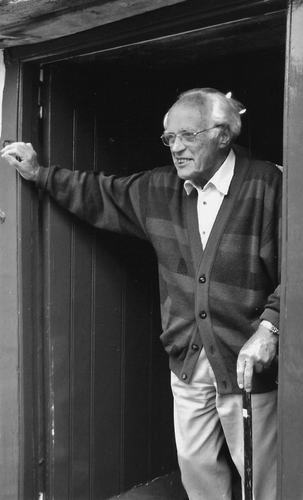
Kenneth Till, who died on the 8th July 2008 aged 88 years was the first full-time paediatric neurosurgeon in the UK and an influential figure in establishing paediatric neurosurgery as a specialty in its own right.
Born in Stoke-on Trent his family later moved south and he attended the Grammar School in Poole before obtaining a scholarship to Downing College, Cambridge. After clinical training at St George's Hospital and military service as a medical officer in the RAF, Kenneth started neurosurgery training in 1945. With a ‘not unfamiliar’ story Kenneth as a junior doctor had wandered into an operating theatre, where the surgeon, a Mr W. McKissock, was so amazed to see anybody interested in neurosurgery that he offered him a job as a house surgeon at Atkinson Morley's Hospital (AMH). Kenneth took responsibility for the small children's ward and became interested in the different pathologies in children, both acquired and congenital.
In 1953 McKissock appointed Kenneth to be his ‘first assistant’ at the Hospital for Sick Children, Great Ormond Street (GOS), although McKissock rarely visited GOS, carrying out most of his activity in the adjacent National Hospital, Queen Square, and at AMH. After further experience, including a sabbatical year in Chicago, Kenneth was appointed consultant neurosurgeon in 1959. He was then single-handed until the appointment of a second neurosurgeon (Norman Grant) in 1970.
The late 1950s saw the introduction of shunts for the surgical treatment of hydrocephalus. The writer Roald Dahl had a son Theo who developed hydrocephalus secondary to a head injury in New York when aged 3–4 months in 1960. There were problems with shunt complications. Encouraged by Dahl, and with the help of an engineer Stanley Wade, Kenneth devised a new shunt, known as the Dahl-Wade-Till (DWT) valve. Outwardly resembling a Holter valve, it prevented the reflux of blood by means of mobile discs of steel and silicone that engaged with flat surfaces when the atrial pressure rose above that in the cerebral ventricles. The author has personally removed (‘revised’) two of these shunts many years after their insertion, suggesting the possibility of effective long-term function.
Kenneth was both a very skilled and fast surgeon being described by his last trainee Jason Brice as ‘the fastest stereotactic surgeon in Europe’. Kenneth's speed was also noted by his anaesthetist Angela Mackersie in describing a time of ‘45 minutes for a patient to return to the ward after going to theatre for the removal of a medulloblastoma!’
Kenneth travelled widely to meet other neurosurgeons committed to the care of children and realized the importance of establishing an international identity for paediatric neurosurgery. The European Society for Paediatric Neurosurgery (ESPN) was formed in 1966 and led to the founding in 1972 of the International Society for Paediatric Neurosurgery (ISPN) with Kenneth as one of 11 founders. He had the honour of hosting the 2nd meeting of the Society at London in 1974. In 1979–80 Kenneth was President of the ISPN and the first to receive the special ‘red poncho’, originally a gift to Anthony Raimondi from Raul Carrea and later a symbol of the presidential office.
In 1975, Kenneth published his book ‘Paediatric Neurosurgery’, written ‘for paediatricians and neurosurgeons’. A single author textbook, it was the state of the art guide for the diagnosis and management of infants and children with neurosurgical problems. For several of us in training at the time this provided the incentive to train in paediatric neurosurgery.
Kenneth practiced at an exciting time with the discovery of non-invasive imaging and he obtained funding for one of the early scanners at GOS thus ensuring that his patients had access to the latest technologies. He recognized the concept of a team approach and was involved in the early development of craniofacial surgery in the UK.
After his retirement in 1980, Kenneth Till continued to quietly, effectively and loyally support the Neurosciences through his Technical Editorship of the British Journal of Neurosurgery (1990–2005) and the Journal of Neurology, Neurosurgery and Psychiatry. Many authors have unknowingly been the beneficiary of his neurosurgical insight and literary skills, so generously given.
Kenneth will be remembered not only for his huge contribution to paediatric neurosurgery and its early development, the many junior surgeons he trained, but also his devoted care of children with major problems and his outstanding ability to communicate with his young patients, their parents and families.
He is survived by his wife, Morwenna, also a doctor previously working in leukaemia research at the Institute of Child Health, and a family of four children and grandchildren.
A. D. Hockley